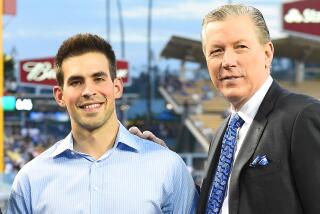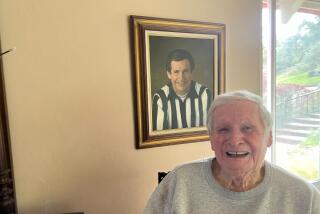He’s Michael Tuck--and Viewers are Split Between Loving Him and Loving to Hate Him
SAN DIEGO — When Michael Tuck was first offered the position of KGTV (Channel 10) commentator on the 11 p.m. news, he told management he didn’t want the job.
“I was anchoring the 5 p.m. and the 6:30 evening newscast, and management said they were looking for some way to get me onto the 11 p.m. news,” Tuck said. “I didn’t want the job. What did I know about commentaries?”
But Tuck was eventually persuaded that commentaries might give him considerably more visibility than anchoring. Exactly. “Michael Tuck’s Perspective” has made him one of San Diego’s best-known television journalists and the highest paid, with an annual salary of nearly $400,000, according to industry sources.
“My first couple of commentaries were pretty soft,” Tuck said. “They were pretty boring. But then I read something in the paper one day--I don’t remember what it was--and I got really mad. I delivered it mad, and the phones started ringing.”
Tuck said he really hit his stride during the 1987 America’s Cup races when San Diego’s Dennis Conner--who skippered the winning vessel and brought the Cup back to the United States--became an overnight national hero. Tuck saw a different side of Conner.
“I called Dennis Conner a jerk,” he said, “because he treated people like he was a jerk. He even threw a reporter off a plane. We received over 600 telephone calls and letters on that commentary.”
The piece struck a collective nerve, and Tuck suddenly found himself thrown into a major public controversy. This was all pretty heady stuff for someone who just a few years earlier was thinking about quitting television journalism.
“I am epileptic and started having on-air seizures,” he said. “I came to a crossroad in my career when I was in Philadelphia (at WCAU-TV). Should I continue, even with the seizures? I started taking increased medication, and I solved the problem. Luckily, all my seizures were petite mal. I’ve never had a grand mal seizure.”
In Philadelphia, Tuck met sportscaster Ted Leitner, who eventually landed a job at San Diego’s KFMB-TV (Channel 8). When Leitner heard the station was looking for a new anchor, he thought of Tuck.
“One day, Leitner called and invited me out to paradise,” Tuck recalled. “I applied for the job and was hired.”
Tuck worked for Channel 8 for six years before joining Channel 10 in 1984.
His commentaries follow a fairly predictable formula. He generally begins by either attacking or praising an individual or organization, then explains his premises and draws a strong conclusion--all served up with a voice that seems to emanate, in tone and intent, from behind a burning bush.
The technique has split his audience between those who love him and those who hate him, with his advocates outnumbering his detractors 2-1, according to station surveys.
Tuck’s journalism colleagues often side with the majority. Among several awards he has won was Sigma Delta Chi’s 1987 Distinguished Service Award for a series of commentaries on former San Diego City Councilman Uvaldo Martinez and his misuses of city credit cards. (Martinez was eventually convicted and left office.)
Another local public official receiving Tuck’s wrath has been San Diego Police Chief Bill Kolender.
“My problem with him is he plays on emotion more than facts,” Kolender said. “He makes personal opinions. It’s real tough when he makes it so personal. We have found him on the facts to be wrong. He knows nothing about facts.”
It seems clear that Tuck devotes as much thought to the style of his commentaries as he does to their content. His loosened-tie, shirt-sleeve delivery is flawless, even if he occasionally speaks like a man possessed. Watching his more impassioned commentaries recalls the image of the broadcaster in the movie “Network” whose commentaries inevitably ended in his ranting, “I’m mad as hell, and I’m not going to take it anymore!”
“Because I’m also an anchor on the evening news,” Tuck said, “I don’t want the viewer to confuse the ‘Perspective’ with when I’m doing straight news. So I do a couple of things. First, I never do a ‘Perspective’ on the same show I anchor. Next, I loosen the tie and take off my jacket. And on the ‘Perspective’ segments, there is always the ‘Michael Tuck’s Perspective’ slide on the screen.
“The trick to this business is learning how to fake sincerity.”
Tuck does look sincere, but by his own admission, he sometimes makes logical errors for the sake of clarity.
“My viewership doesn’t want to listen to me make esoteric points,” he said. “They want things they can relate to, things they can understand. This means I have to use simple, direct language that makes sense to them.”
Occasionally, the effort at simplification makes Tuck look like a media demagogue, as it did when he claimed that a local government contractor was a “traitor” for cheating on his contracts with NASA.
But it does make for interesting television. And two out of three viewers seem to like it that way.
More to Read
The complete guide to home viewing
Get Screen Gab for everything about the TV shows and streaming movies everyone’s talking about.
You may occasionally receive promotional content from the Los Angeles Times.






